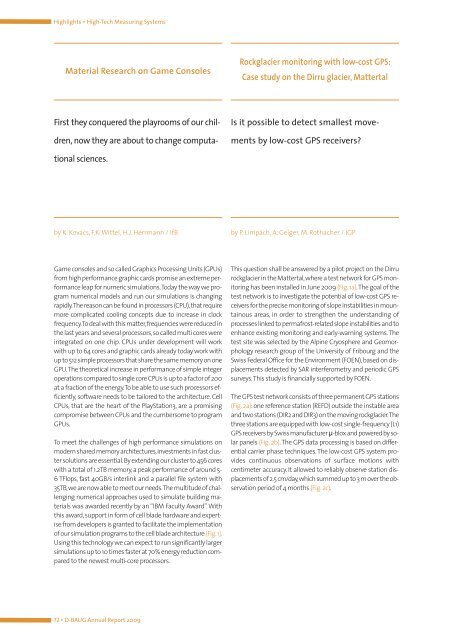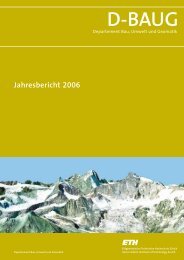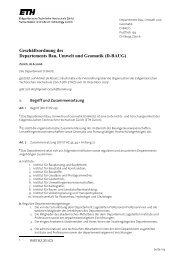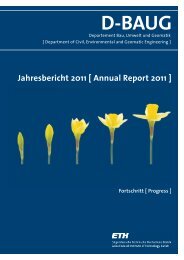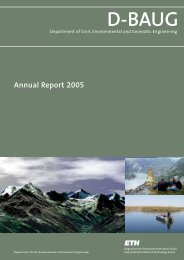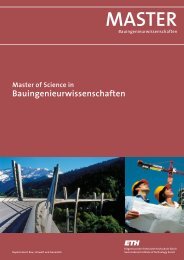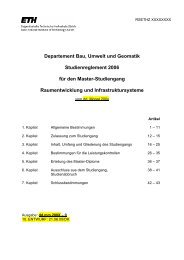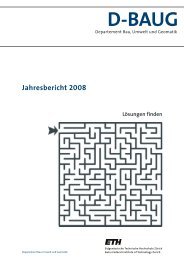D-BAUG - Departement Bau, Umwelt und Geomatik - ETH Zürich
D-BAUG - Departement Bau, Umwelt und Geomatik - ETH Zürich
D-BAUG - Departement Bau, Umwelt und Geomatik - ETH Zürich
You also want an ePaper? Increase the reach of your titles
YUMPU automatically turns print PDFs into web optimized ePapers that Google loves.
Highlights ▪ High-Tech Measuring Systems<br />
Material Research on Game Consoles<br />
First they conquered the playrooms of our chil-<br />
dren, now they are about to change computa-<br />
tional sciences.<br />
by K. Kovacs, F.K. Wittel, H.J. Herrmann / IfB<br />
Game consoles and so called Graphics Processing Units (GPUs)<br />
from high performance graphic cards promise an extreme performance<br />
leap for numeric simulations.Today the way we program<br />
numerical models and run our simulations is changing<br />
rapidly.Thereasoncanbefo<strong>und</strong>inprocessors(CPU),that require<br />
more complicated cooling concepts due to increase in clock<br />
frequency.To deal with this matter,frequencies were reduced in<br />
the last years and several processors,so called multi cores were<br />
integrated on one chip. CPUs <strong>und</strong>er development will work<br />
with up to 64 cores and graphic cards already today work with<br />
up to512simpleprocessors that share thesamememoryonone<br />
GPU.The theoretical increase in performance of simple integer<br />
operationscompared tosinglecoreCPUsisup toafactorof200<br />
at a fraction of the energy.To be able to use such processors efficiently,<br />
software needs to be tailored to the architecture. Cell<br />
CPUs, that are the heart of the PlayStation3, are a promising<br />
compromise between CPUs and the cumbersome to program<br />
GPUs.<br />
To meet the challenges of high performance simulations on<br />
modernsharedmemory architectures,investments infast cluster<br />
solutions are essential.By extending our cluster to 456 cores<br />
with a total of 1.2TB memory,a peak performance of aro<strong>und</strong> 5-<br />
6 TFlops, fast 40GB/s interlink and a parallel file system with<br />
35TB,wearenowable tomeet ourneeds.Themultitudeofchallenging<br />
numerical approaches used to simulate building materials<br />
was awarded recently by an “IBM Faculty Award”. With<br />
this award,support in form of cell blade hardware and expertise<br />
from developers is granted to facilitate the implementation<br />
of our simulation programs to the cell blade architecture (Fig.1).<br />
Using this technology we can expect to run significantly larger<br />
simulationsup to10 times faster at 70% energy reductioncompared<br />
to the newest multi-core processors.<br />
72 ▪ D-<strong>BAUG</strong> Annual Report 2009<br />
Rockglacier monitoring with low-cost GPS:<br />
Case study on the Dirru glacier, Mattertal<br />
Is it possible to detect smallest move-<br />
ments by low-cost GPS receivers?<br />
by P. Limpach, A. Geiger, M. Rothacher / IGP<br />
This question shall be answered by a pilot project on the Dirru<br />
rockglacier in the Mattertal,where a test network for GPS monitoring<br />
has been installed in June 2009 (Fig.1a).The goal of the<br />
test network is to investigate the potential of low-cost GPS receiversfortheprecisemonitoringofslopeinstabilitiesinmountainous<br />
areas, in order to strengthen the <strong>und</strong>erstanding of<br />
processeslinked to permafrost-related slope instabilities and to<br />
enhance existing monitoring and early-warning systems. The<br />
test site was selected by the Alpine Cryosphere and Geomorphology<br />
research group of the University of Fribourg and the<br />
Swiss Federal Office for the Environment (FOEN),based on displacements<br />
detected by SAR interferometry and periodic GPS<br />
surveys.This study is financially supported by FOEN.<br />
The GPS test network consistsof three permanent GPSstations<br />
(Fig. 2a):one reference station (REFD) outside the instable area<br />
and twostations(DIR2 andDIR3)on the movingrockglacier.The<br />
three stations are equipped with low-cost single-frequency (L1)<br />
GPSreceiversbySwissmanufacturerµ-bloxandpoweredbysolar<br />
panels (Fig. 2b).The GPS data processing is based on differential<br />
carrier phase techniques.The low-cost GPS system provides<br />
continuous observations of surface motions with<br />
centimeter accuracy. It allowed to reliably observe station displacementsof2.5cm/day,whichsummedup<br />
to3mover theobservation<br />
period of 4 months (Fig.2c).


